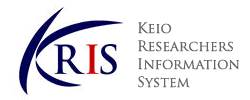-
Affiliation
-
Faculty of Pharmacy, Department of Pharmacy 天然医薬資源学講座 (Shiba-Kyoritsu)
-
Position
-
Professor

KEIO RESEARCHERS INFORMATION SYSTEM |
Details of a Researcher
このページはJavascriptを使用しています。すべての機能を使用するためにはJavascript を有効にする必要があります。
Kikuchi, Haruhisa
|
|
東北大学, 薬学部, 助手
東北大学, 大学院薬学研究科, 助手
東北大学, 大学院薬学研究科, 助教
東北大学, 大学院薬学研究科, 准教授
慶應義塾大学, 薬学部, 教授
Life Science / Environmental and natural pharmaceutical resources (Natural Product Chemistry)
細胞性粘菌:研究の新展開〜モデル生物,創薬資源,バイオ〜
菊地晴久, 久保原禅, アイピーシー出版, 2012
Scope: 第10章 創薬資源としての細胞性粘菌
Kana Koinuma, Kenji Noto, Tokio Morita, Yoshinori Uekusa, Haruhisa Kikuchi, Miyuki Shimoji, Hiroyuki Seki, Hiroshi Yamazaki, F. Peter Guengerich, Katsunori Nakamura, Koujirou Yamamoto, Ayuko Imaoka, Takeshi Akiyoshi, Hisakazu Ohtani
Journal of Pharmaceutical Sciences (Elsevier BV) 114 ( 2 ) 849 - 856 2024.10
Research paper (scientific journal), Accepted, ISSN 0022-3549
Naoko Yoshida, Haruhisa Kikuchi, Makoto Hirai, Betty Balikagala, Denis A. Anywar, Hikari Taka, Naoko Kaga, Yoshiki Miura, Naoyuki Fukuda, Emmanuel I. Odongo-Aginya, Yuzuru Kubohara, Toshihiro Mita
Biochemical Pharmacology (Elsevier BV) 225 116243 - 116243 2024.07
Research paper (scientific journal), Accepted, ISSN 0006-2952
Takehiro Nishimura, Kosuke Shiga, Mizuki Sekiya, Akihiro Sugawara, Takayuki Yonezawa, Haruhisa Kikuchi
Chemistry (Weinheim an der Bergstrasse, Germany) 30 ( 48 ) e202402082 2024.06
Research paper (scientific journal), Corresponding author, Accepted, ISSN 09476539
Takehiro Nishimura, Takuya Murotani, Hitomi Sasaki, Yoshinori Uekusa, Hiromi Eguchi, Hirotaka Ishigaki, Katsunori Takahashi, Yuzuru Kubohara, Haruhisa Kikuchi
Molecules (MDPI AG) 29 ( 9 ) 2143 - 2143 2024.05
Research paper (scientific journal), Accepted
Anti-trypanosomal Lignans Isolated from Salvadoran <i>Peperomia pseudopereskiifolia</i>
Ulises G. Castillo, Yoshinori Uekusa, Takehiro Nishimura, Fumiyuki Kiuchi, Morena L. Martínez, Jenny Menjívar, Junko Nakajima-Shimada, Marvin J. Núñez, Haruhisa Kikuchi
Journal of Natural Products (American Chemical Society (ACS)) 87 ( 4 ) 1067 - 1074 2024.04
Research paper (scientific journal), Corresponding author, Accepted, ISSN 0163-3864
Utilization of unexploited protists into drug discovery resources
Kikuchi, Haruhisa
学事振興資金研究成果実績報告書 (慶應義塾大学) 2023
Development of a library of natural compounds analogues with introduced non-living elements
Kikuchi, Haruhisa
福澤諭吉記念慶應義塾学事振興基金事業報告集 (福澤基金運営委員会) 2023
Utilization of unexploited protists into drug discovery resources
Kikuchi, Haruhisa
学事振興資金研究成果実績報告書 (慶應義塾大学) 2022
Kikuchi, Haruhisa
福澤諭吉記念慶應義塾学事振興基金事業報告集 (福澤基金運営委員会) 2022
Development of biologically active compounds with diversity beyond that of natural compounds
Kikuchi, Haruhisa
科学研究費補助金研究成果報告書 2021
ケミカルバイオロジーの冒険(6)生体を制御するための化学 天然物関連の生物活性分子開発
叶 直樹, 菊地晴久, 高岡洋輔
現代化学 ( 642 ) 45 - 52 2024.09
New Development of Disaster-Related and Tropical Infectious Diseases Control
Gaowa Bai, Toshiro Niki, Haruhisa Kikuchi, Ayako Sumi, Nobuyuki Kobayashi, Takahiro Haruyama, Jing Zhang, Haorile Chagan-Yasutan, Toshio Hattori
Reports — Medical Cases, Images, and Videos (MDPI AG) 3 ( 1 ) 5 - 5 2020.03
Other, Joint Work
Development of Natural Product-like Library by Using Diversity-enhanced Extracts
Kikuchi H, Oshima Y
MedChem News 24 ( 2 ) 45 - 51 2014
Article, review, commentary, editorial, etc. (trade magazine, newspaper, online media), Joint Work
Novel biologically active compounds isolated from unexploited organisms, cellular sime molds
Haruhisa Kikuchi
YAKUGAKU ZASSHI-JOURNAL OF THE PHARMACEUTICAL SOCIETY OF JAPAN (PHARMACEUTICAL SOC JAPAN) 127 ( 9 ) 1431 - 1439 2007
Book review, literature introduction, etc., Single Work, ISSN 0031-6903
細胞性粘菌の生活環を制御する物質−単細胞から多細胞への移行をコントロールするα-ピロノイド
大島吉輝, 菊地晴久, 前田靖男
化学と生物 40 ( 2 ) 76 - 77 2002
Article, review, commentary, editorial, etc. (trade magazine, newspaper, online media), Joint Work, ISSN 0453-073X
リグナンラクトン類の構造を基盤とした抗トリパノソーマ活性化合物の創出
多田真里菜, 西村壮央, 谷優香, 菊地晴久
[Domestic presentation] 日本薬学会第145年会,
Poster presentation
エルサルバドル産植物を用いた抗トリパノソーマ活性天然物の探索
山内雄斗, 西村壮央, 植草義徳, Marvin J. Núñez, 嶋田淳子, 菊地晴久
[Domestic presentation] 日本薬学会第145年会,
Oral presentation (general)
アビエチン酸の環骨格の再構築戦略に基づく中分子化合物群の創出
小林史明, 西村壮央, 菊地晴久
[Domestic presentation] 日本薬学会第145年会,
Oral presentation (general)
β-ラクトン骨格を特徴とする クラス D β-ラクタマーゼ特異的阻害剤 JBIR-155 の合成研究
吉田慶季, 西村壮央, 菊地晴久
[Domestic presentation] 日本薬学会第145年会,
Oral presentation (general)
卵菌 Sprolegnia parasitica が産生する新規コレスタン型化合物の単離および構造決定
櫻井廣祐,西村壮央,植草義徳,菊地晴久
[Domestic presentation] 日本生薬学会第70回年会,
Oral presentation (general)
天然化合物を越える多様性を有した生物活性指向型化合物ライブラリーの構築
MEXT,JSPS, Grant-in-Aid for Scientific Research, Grant-in-Aid for Scientific Research (B), Principal investigator
不飽和複素5員環含有化合物を含有する肺高血圧症の予防又は治療剤
Date applied: JP2017025822 2017.07
Date announced: WO2018-012634 2018.01
Patent
ジクチオピロン誘導体又はジヒドロジクチオピロン誘導体を有効成分とするオステオポンチン産生阻害剤
Date applied: JP2013006943 2013.11
Date announced: WO2014-136161 2014.09
Patent
ジクチオピロン誘導体又はジヒドロジクチオピロン誘導体を有効成分とするオステオポンチン産生阻害剤
Date applied: 特願2014-552995 2013.11
Date issued: 特許第5716140号 2015.03
Patent
日本生薬学会学術貢献賞
2022, 日本生薬学会
9th Intelligent Cosmos Encouragement Prize
2010
Award of 46th Symposium on the Chemistry of Natural Products
2004
Type of Award: Award from Japanese society, conference, symposium, etc.
THE JAPANESE PHARMACOPOEIA
2025
STUDY OF MAJOR FIELD: (NATURAL MEDICINES)
2025
SPECTROSCOPY IN ORGANIC CHEMISTRY
2025
SEMINAR: (NATURAL MEDICINES)
2025
RESEARCH FOR BACHELOR'S THESIS 1
2025